Contrio features include:
- Analog & Ethernet Wall Controllers
- Compatible with BSS Audio Soundweb London, Crown DCi, and other HiQnet devices
- Available in Black or White
- Available in US Decora or EU Version
- Single & Dual-Gang Size
- PoE (Power Over Ethernet)
- Configured within Audio Architect.
- 1 Programmable Push/Rotary Encoder
- 1 Programmable Encoder Ring (Multicolored)
- Up to 8 Programmable Buttons (Multicolored)
- Up to 2 Programmable 64x128 Pixel LCDs (Multicolored)
- Sleep Function
- Security: Remote Lock/Unlock and Local Unlock via PIN Entry
- Multiple Modes of Operation
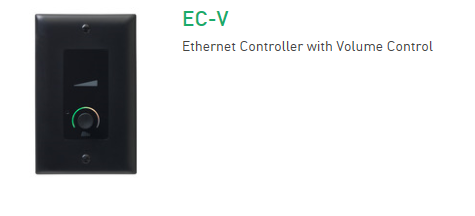
Type: Ethernet Controller… This controller provides a single rotary control that can also be pushed for a single button type trigger and a ring meter if desired.
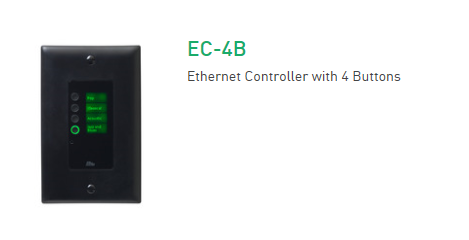
Type: Ethernet Controller… This controller provides four buttons to make selections with. (no rotary control)
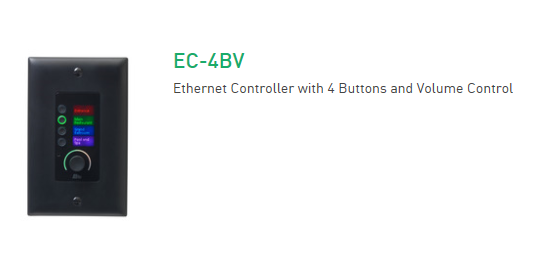
Type: Ethernet Control… This controller provides four buttons and a rotary control for volume or fader control and also has a push button on the rotary knob and a meter around the knob.
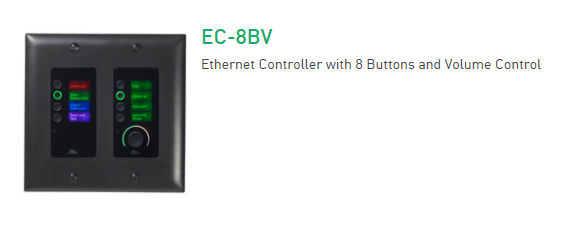
Type: Ethernet Controller… This has 8 buttons in two groups of four and a single rotary control combined with a push button and a meter around rotary knob.

Type: Analog Controller… This controller provides a potentiometer for volume control but it must interface with the BSS hardware through a GPIO port for analog input.
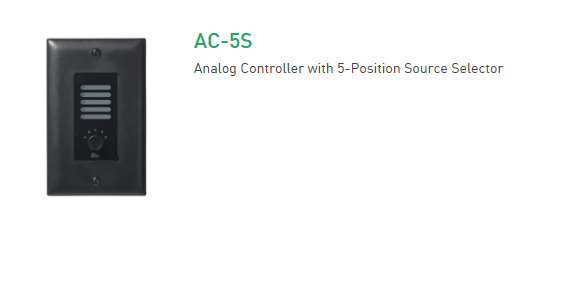
Type: Analog Controller… This controller provides 5 switches usually used for selection control but it must interface with the BSS hardware through a GPIO port for analog input.
Contrio Connectivity:
EC – controllers are network based and require PoE power either from a PoE injector or a switch that provides power to its ports.
AC – Controllers connect to control ports and provide control for an object assigned to that control port.
Any controllers that starts with EC are a controller that works over Ethernet networking to control what you program them to control.
If the controller starts with AC that means it is an analog controller and must interface through the GPIO ports on the back of the BSS device.
Power:

All EC controllers require power from a source of PoE or power over Ethernet. A switch that can provide PoE or some sort of PoE injector is required with enough current to support the number of devices you are planning to use.
PoE injectors come in two varieties, PoE, that supplies up to 15.4 watts per port and PoE+, which supplies up to 30 watts per port. Either will drive the contrio because PoE+ power is backward compatible with PoE.
If you use a switch that supplies PoE on it's ports make sure you have enough total current. If a switch supplies total current up to 240 watts you can divide the max by the per port value(15.4 for PoE or 30 for PoE+) 240/15.4 = 15 ports possible on PoE or 240/30 = 8 ports. The math basically means that only 15 or 8 contrios can be supported on a switch even if the switch has more ports… power is added up and switches eventually run out of power to supply. If you try to run more they may or may not work depending on the way they are designed to distribute power.
- A Design using a contrio and a Non-PoE switch with a PoE injector for power
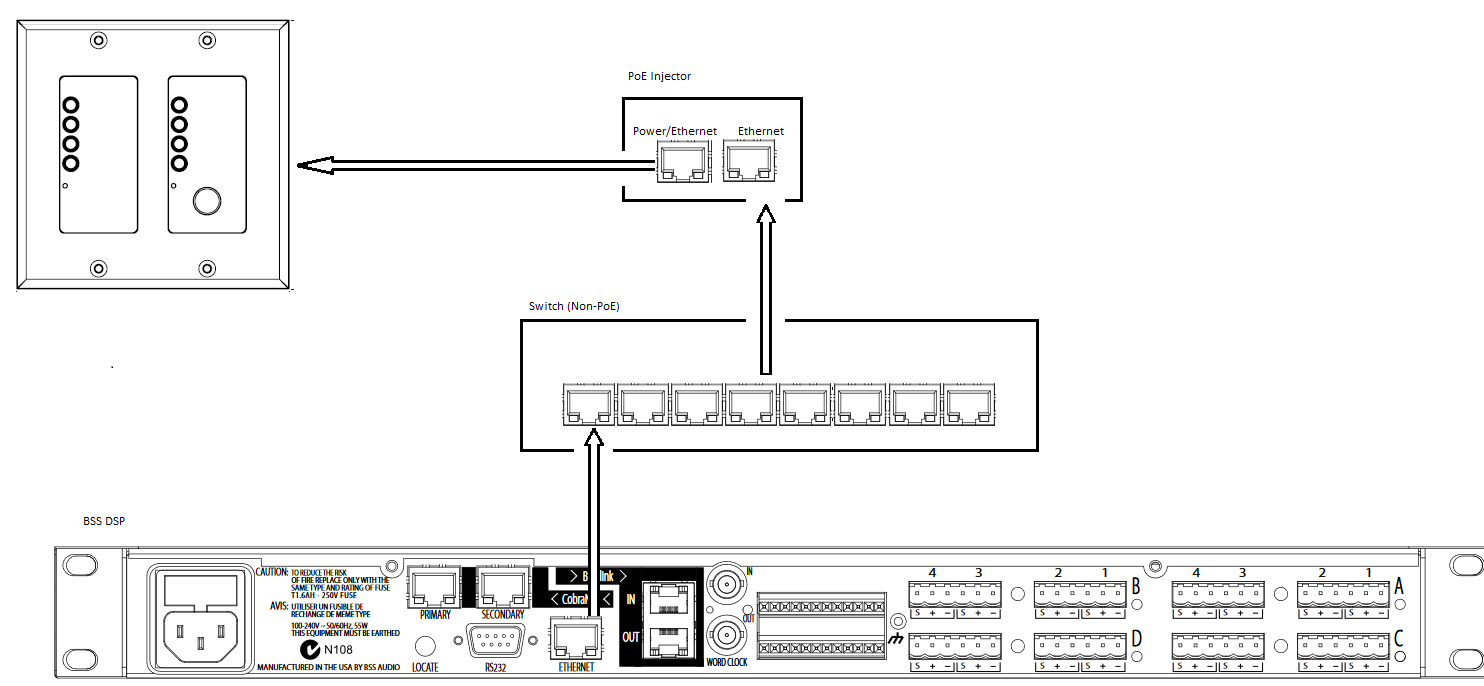
In this connection the DSP is connected to a switch that does NOT supply PoE and the switch is then connected to a PoE injector that then supplies both the data and power to the contrio.
It is possible in this scenario, to bypass the switch altogether using a crossover cable in a case where there is only one DSP and one controller but having this switch makes it easier to connect with and program the hardware using audio architect.
- A Design using a switch that also provides PoE
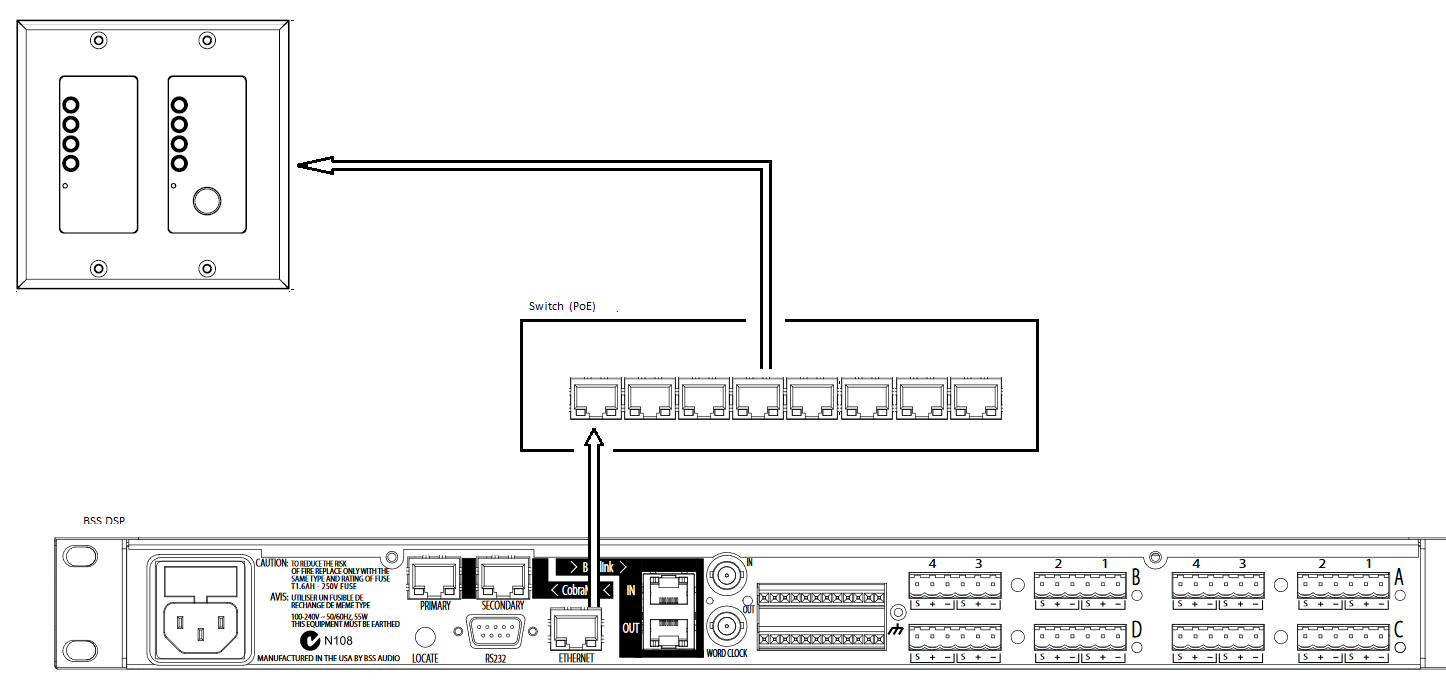
In this connection, the switch is required since that is where the PoE source comes from to power the Contrio. The port that the DSP connects to should NOT be enabled for PoE but the port connected to the Contrio should have PoE enabled.
- Analog controllers connect to the control ports on the back of the DSP. AC controllers or analog controllers do not use power except what is available on the GPIO control ports.
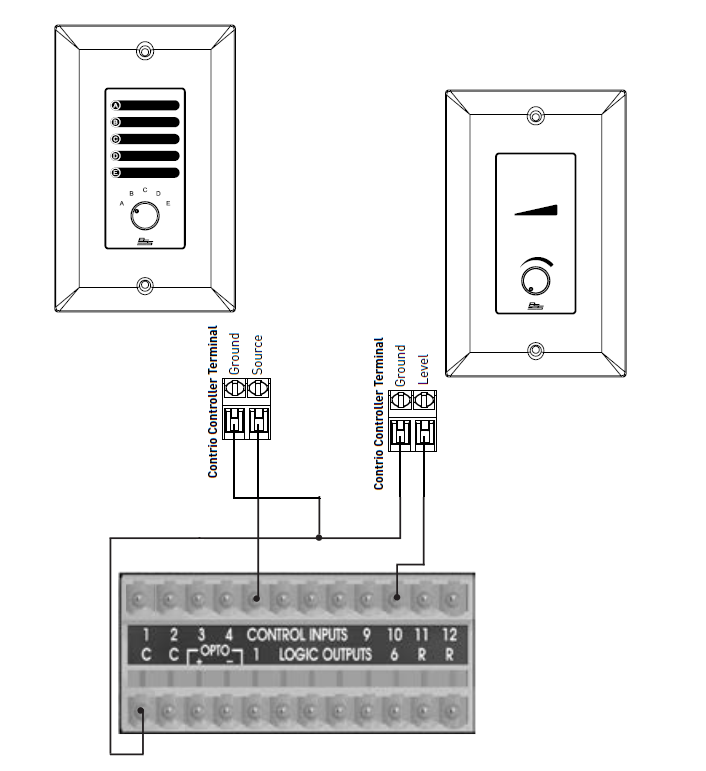
What modes are available for each
unit?

Modes: None.
This is really just a volume control
knob. It can be assigned to anything
that has a continuous adjustment such as a mixer fader or a fader on a mono
gain.

To assign a fader from a floating GUI
like a mixer or mono gain you can double click to open the control panel and then
go to your Contrio controller edit screen and hold down control(command if on a mac) and click and
drag the fader to the appropriate line for the continuous control.
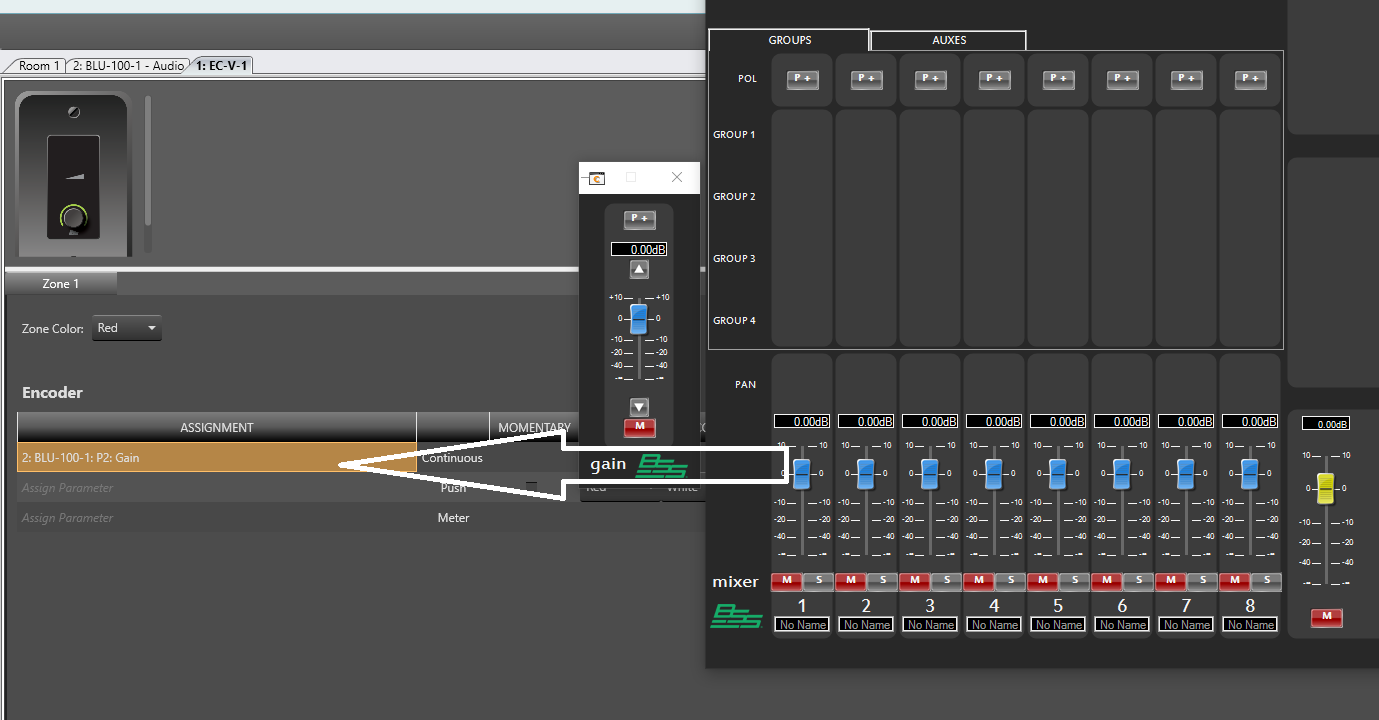
The Knob also has a push button and an LED meter built into the knob(this is a feature of all EC Contrios with the knob.) Many people
choose to make the push button into a mute or some sort of trigger for a preset
level. That is up to you.

Modes: None.
This control is simply four buttons
but it does have a display for a name of each.
Buttons can be assigned to any “direct action” parameter like mutes or
presets or other button-type operations.


Modes:
Single Zone, 4-Zone and Hybrid.
Single Zone:
In single zone the EC-4BV can control
up to four direction action controls and one continuous and one meter and one
push(techinically a 5th direct action control)
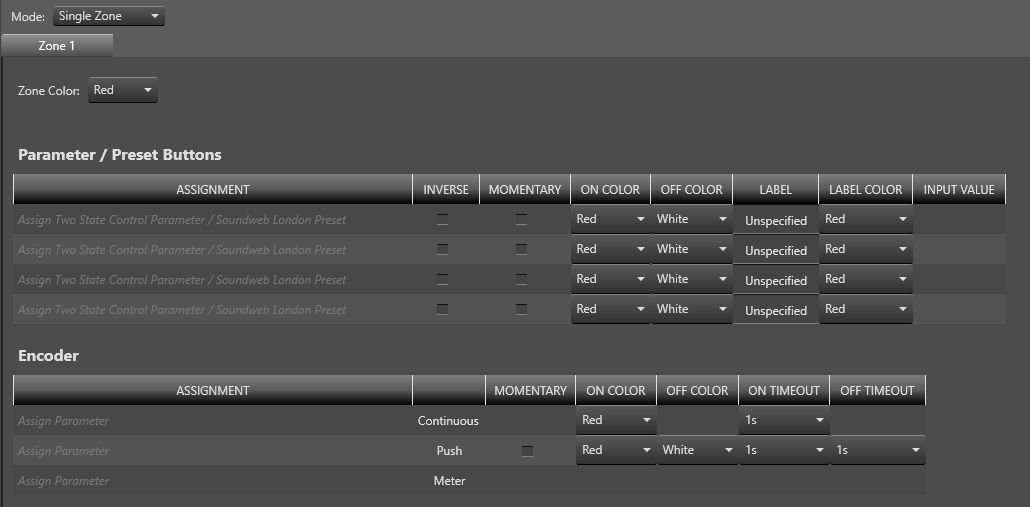
4-Zone:
In 4 zone mode with an EC-4BV you can control up to 4
different volume controls by selecting the button that makes the knob control
the desired continuous control. Programming
them requires one to click to the zone and then assign the appropriate control
for each zone in the same way all the assignments have been done so far.
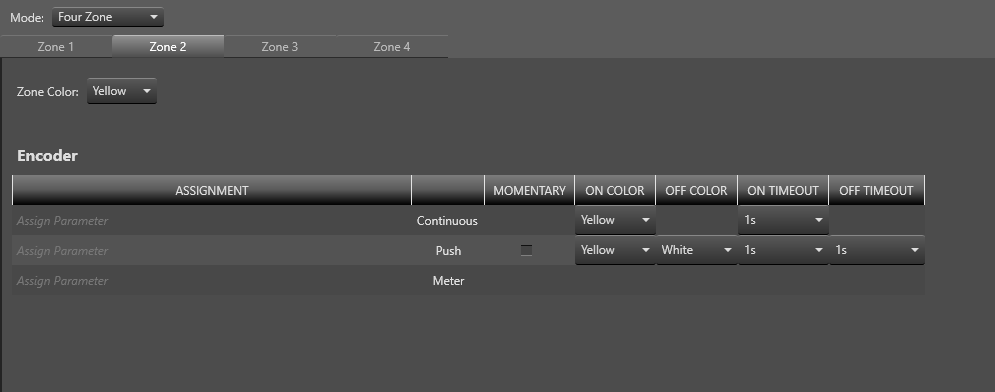
Hybrid:
In hybrid mode with an EC-4BV some buttons can
provide direct action and others can select zones so you only have to determine
which buttons of the four will be direct action and which will select a zone…
remember there are only 4 buttons to work with.
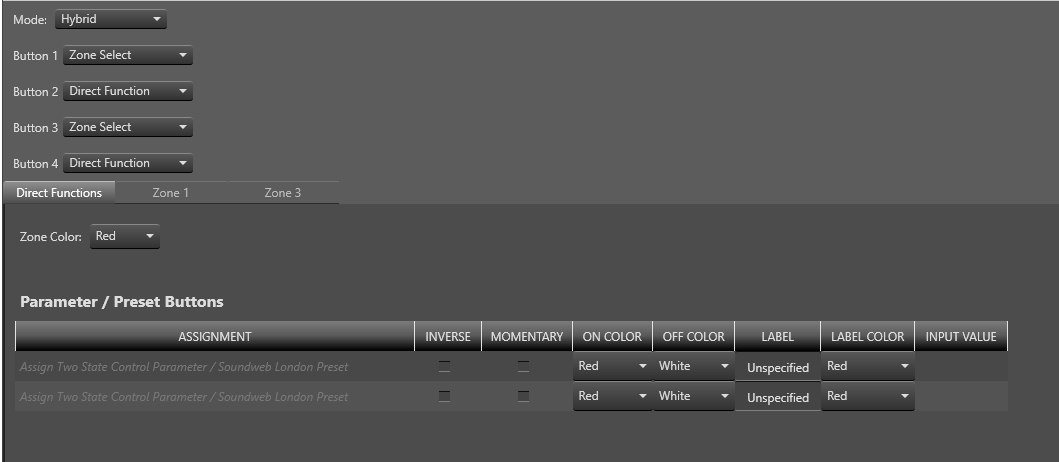

Modes: Single Zone, Four Zone, Eight
Zone, Four by Four, and Hybrid.
Single Zone:
Single mode works in the same way as
the EC-4BV except that you now have 8 direct action controls that can be
assigned and controlled.

Four Zone:
Four Zone works the same as the EC-4BV
except that you now have 4 direct action buttons in addition to the continuous controller
in each zone. It’s like having 4
EC-4BV’s in the same wall box!
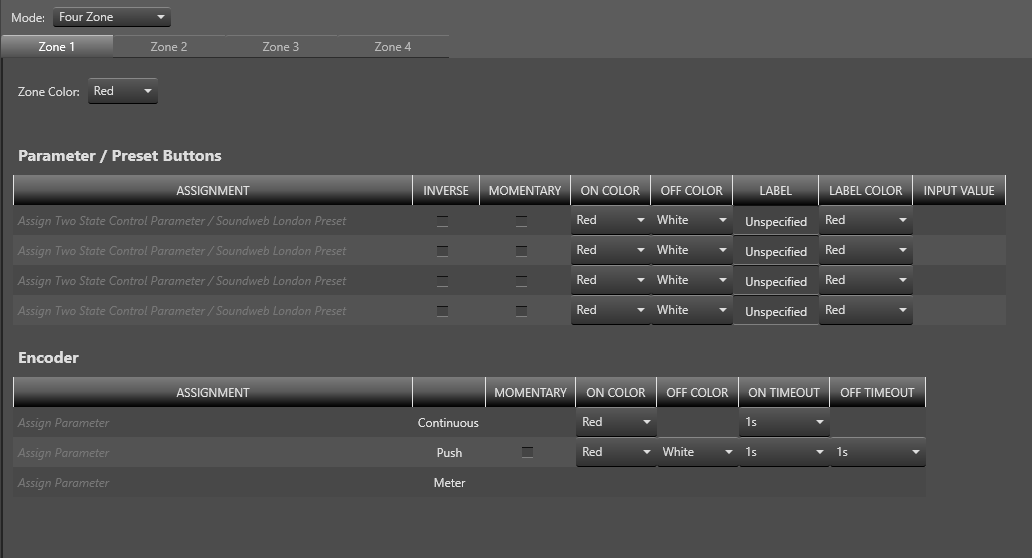
Eight Zone:
In Eight zone mode(possible only on the EC-8BV) you now have eight
buttons that each select a separate volume or continuous controller.
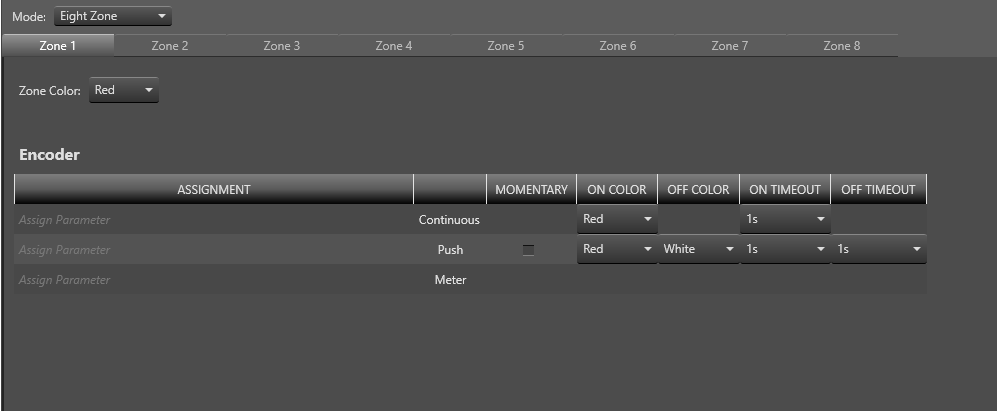
Four by Four:
Four by four on the EC-8BV gives you the ability to
control up to sixteen continuous controllers.
On the left buttons select the zone and on the right buttons select the
continuous controller in that zone to adjust its value.
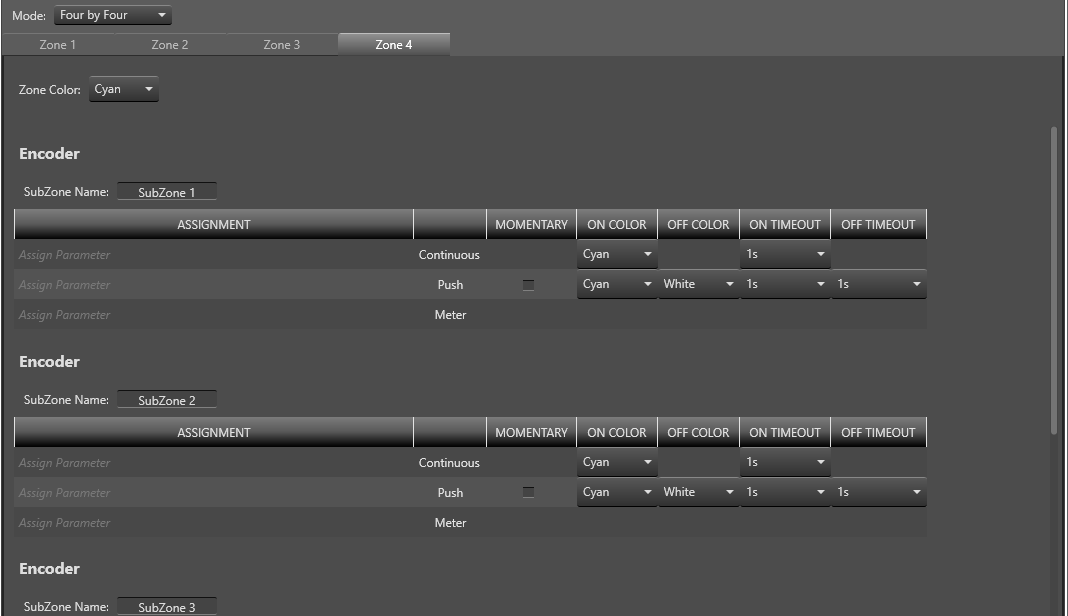
Hybrid:
Hybrid mode on the EC-8BV allows you to determine what
each of the 4 buttons on the right will do.
If you set it for four zone then that button will allow the four buttons
on the right to select four direct action applications and a continuous
controller in that “zone.”
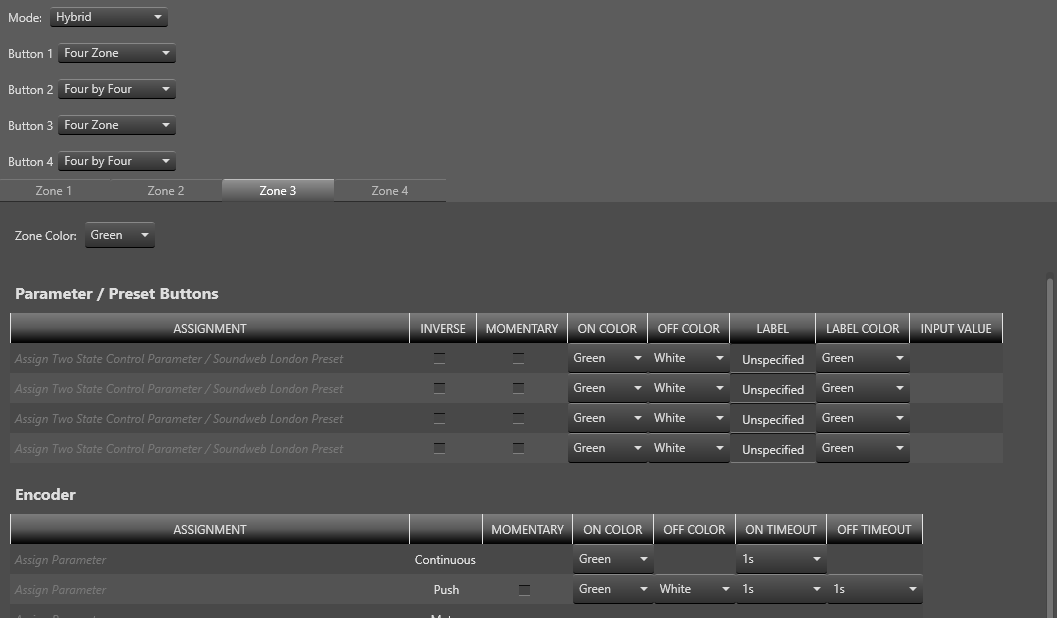
If the zone is set to four by four
then that then the buttons on the right determine which volume or continuous control
the knob will control.
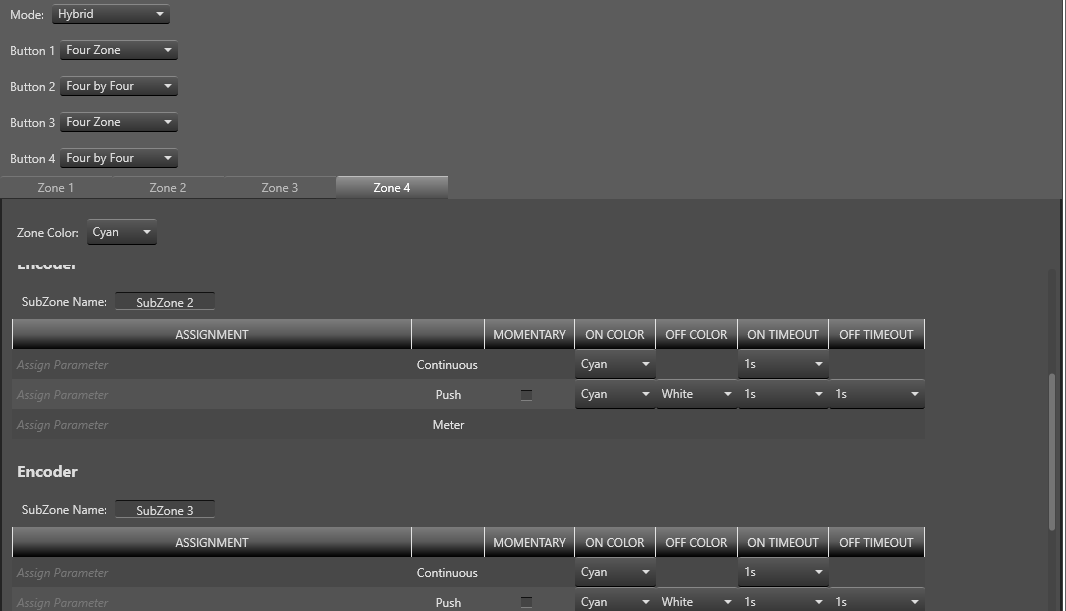
Hybrid can be very useful to mix up
the object you are controlling but it may take more training on the part of
your client to use correctly.
Mounting Contrios in a box
Wall boxes are required by most electrical codes for mounting these controllers.
What wall boxes
are required for Contrios?
US Contrios will fit in Decora Style wall boxes:
One EC-V, EC-B, or EC-4BV can be fit in a single gang US decora wall
boxes.
One EC-8BV can be fitted in a double gang decora wall box only.

European Contrios fit in to UK or EU style wall boxes:
One EC-V, EC-B, or EC-4BV can fit in a single gang UK or single gang EU wall
box.
One EC-8BV can be fitted in a double gang UK wall box only.
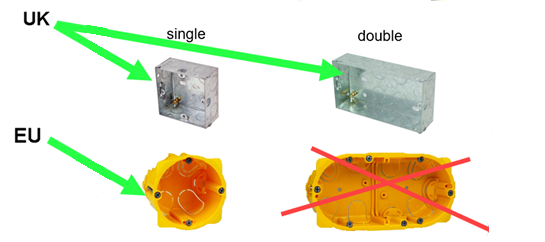
Notes on Wall Boxes:
- Wall boxes are not available from Harman.
- The
analog Contrio controllers(AC models) have depth of 25mm or 1 inch
- The network Contrio controllers(EC models) have a depth of 40mm or 1.5 inches
Other Important things to know:
Factory Reset
The
Factory Reset will revert an Ethernet Contrio controller back to its
un-configured, factory-default state by deleting its configuration and
clearing any set IP address information. Please note in the drawings the location of the locate button on the controllers. The EC-8BV has two and they are interchangable. If for some reason you have trouble using one you may try the other.

To Factory Reset a controller:
1. Power off the controller.
2. Apply power to the controller while pressing and holding the Locate button(see the image above)
3. Keep the Locate button held until the screen goes blank and then offers a boot menu(usually within 30 seconds but in some cases it could take up to 2 minutes.)
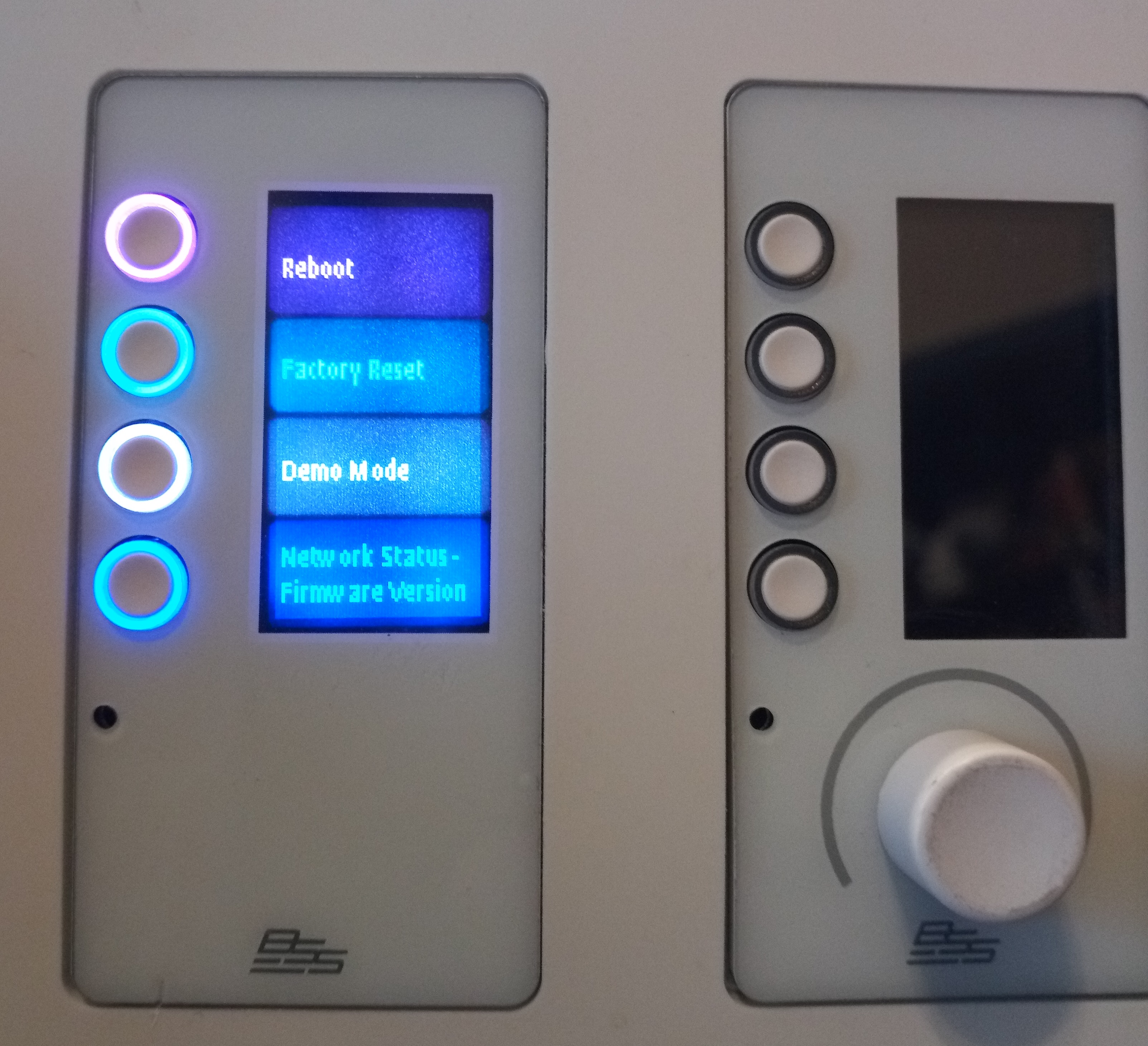 Boot Menu
Boot Menu
Important notes:
- If
working with an EC-V, the controller will now perform the Factory Reset
after holding the button for about 30-60 seconds and you don't need to
perform any of the following steps. There is no indication of this
because there is no display on the EC-V.
- If using the EC-4B, EC-4BV, or EC-8BV, the Boot Menu options should now be displayed and you can continue to step 4.
4. Select the 'Factory Reset' option by pressing the corresponding button.
- Selecting
the 'Reboot' option rather the “Factory Reset" will only restart the
controller without clearing the configuration and IP address.
- Selecting Demo mode will put the mode into one of two demo modes which you can select.
- Selecting Network Status will show the IP address and MAC address of the device.
5. The Factory Reset will now be performed.
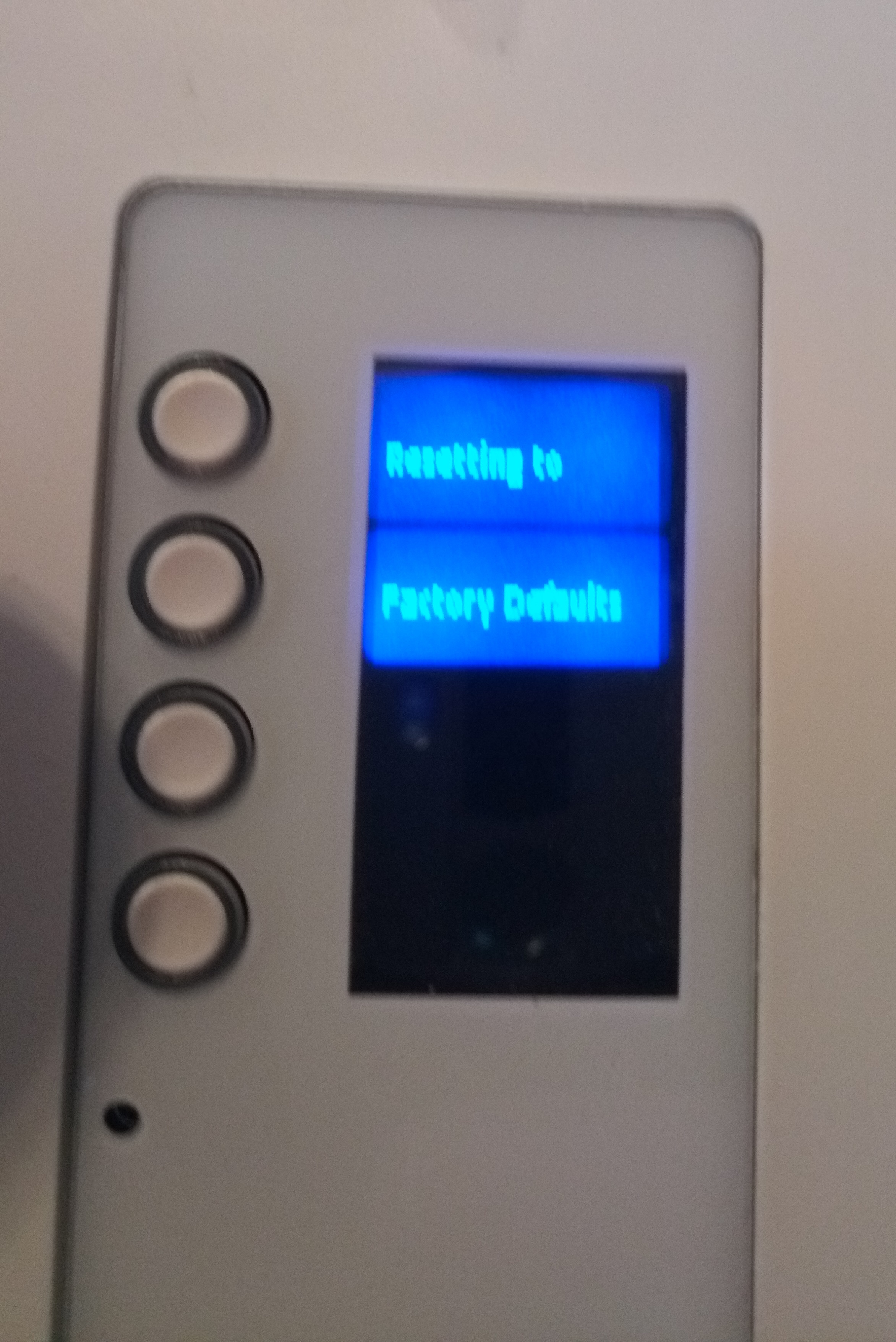
To Restart a controller:
Perform
the Restart procedure if an Ethernet Contrio controller becomes
unresponsive. This procedure will restart a controller without having to
disconnect power to the device. Configuration and IP address
information will not be lost when performing the Restart procedure.
To Restart a controller:
Power cycling the controller by unplugging and replugging the network cable.

or
Restart using the buttons on the controller.
1. With the controller powered on, press and hold any button or encoder for approximately 20-30 seconds.
2. The controller will now power cycle and reboot with the current configuration and IP settings.
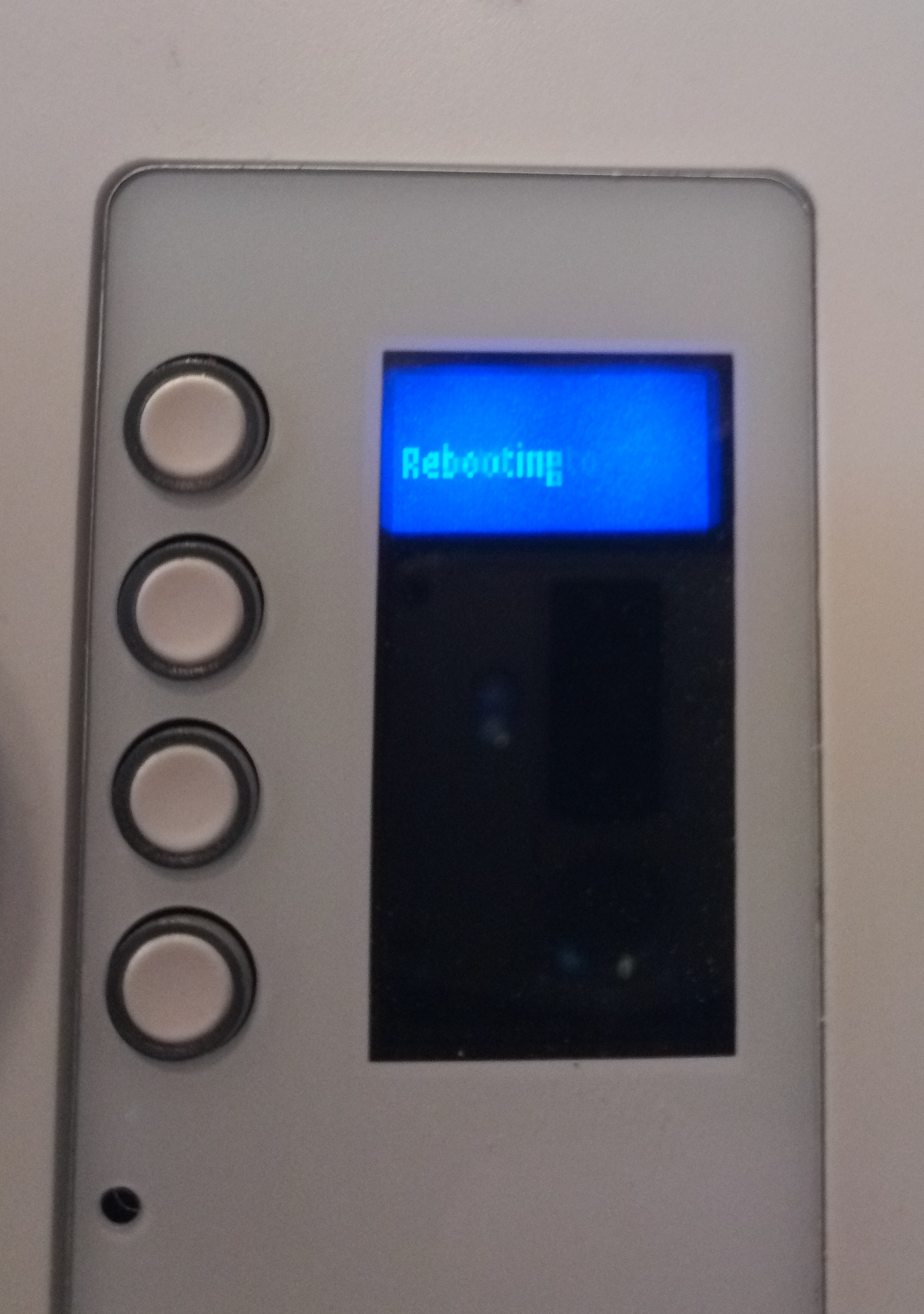
NOTE:
There is no Restart procedure for the EC-V controller. To Restart an
EC-V controller, power must be disconnected from the controller then
reconnected, or the PoE device supplying power must be power cycled